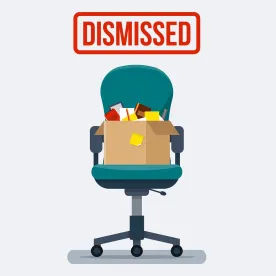The Board is now operating at a full complement and is issuing decisions on a fairly regular basis. Nothing earth shattering in terms of law (which is kind of a relief) but there are some interesting issues worth discussing. A frequent topic of discussion here is the often blurry line between what constitutes “protected” versus “unprotected” employee conduct and how difficult it can be to defend claims that a discipline or termination violated the Act. See some examples here, here and here. When there is an ongoing labor dispute, such as a strike, it can be difficult to discipline or discharge an employee for misconduct that is bound up with the dispute.
In a recent NLRB decision, the employer’s thorough and complete investigation helped establish the lawfulness of its termination of some employees whose misconduct occurred in the midst of a strike.
In Kapstone Paper and Packaging Corporation, 366 NLRB No. 63 (April 20, 2018) the Board was confronted with a situation where negotiations over a new contract stalled and a strike occurred. During the few days of the strike four employees were terminated for misconduct. These terminations formed the basis of the charges alleging the employer discriminated against the employees in violation of Section 8(a)(3) of the Act.
The Employer’s Operation
Employer operates a paper and pulp mill in the state of Washington where approximately 1,000 unionized employees work. The employer’s operation is “situated in a remote location, accessible by a single, one-mile road–Fiber Way.” The road does not have any residential or commercial development and all employees drive their private vehicles to the plant.
Union Negotiations Break Down; a Strike Is Called
The parties were “embroiled” in contract negotiations which failed to produce an agreement. The union threatened a strike, to which the employer responded by writing a letter to the union warning that “any employee who engages in serious strike misconduct (e.g., violence damage to property, threats of bodily harm) or violations of the law” would be subject to discipline or discharge.
The union eventually went out on strike. The union held required training sessions for all employees which reinforced that union members were to “exhibit normal, respectful behavior on the picket line.” Strikers were also given the union’s “Picket Line Dos and Don’ts” which further detailed appropriate picket line conduct. These rules specifically stated, among other things, that strikers were not to “swarm” vehicles entering/exiting the plant, which was defined as standing collectively in front of or surround vehicles or obstruct vehicles’ entrances or exits.
Employee Kicks One Vehicle Causing Damage and Jumps on the Hood of Another
One striker who had attended training on dos and don’ts was on picket line duty with approximately 10-15 other strikers. A pickup truck from one of the employer’s contractors entered the mill and the employee kicked the passenger side rear panel which appeared to cause damage.
In a separate incident occurring an hour later the employee and some of other picketers gathered in front of a vehicle leaving the mill. One picketer stated, “there’s another one” a presumed reference to the fact the vehicle belonged to a contractor. When the vehicle stopped the employee jumped on the hood and as he did so his picket sign made contact with the windshield. When the picketers parted the vehicle accelerated throwing the picketing employee off.
Both incidents were caught on videotape.
The Employer Obtains an Injunction
The kicking incident and others formed the basis for the employer’s application for and grant of a state court injunction which stated, in part, that “No one will attempt to block or impede traffic entering or leaving the. . . mill site.”
Three Employees Block Exiting Semi-truck
After the injunction was issued, three picketers, all of whom had received the union’s training, decided to position themselves in such a manner so as to block larger trucks that needed to make a wide turn onto the access road from the mill gate. Although the three employees were on the access road “right of way” they knew that by standing where trucks had to turn they would cause a “choke” point which would force the driver of the truck have to make a choice between hitting some parked cars or hitting the picketers. One truck physically could not make the turn and could not back up so the picketers effectively blocked all ingress and egress to the mill. Law enforcement was called and after an exchange the picketers finally moved.
The Employer Investigates the Incidents and Decides to Terminate the Four Employees
The employer’s security manager, who had conducted numerous investigations for the employer, conducted the investigation into these incidents. The security manager reviewed all the videotape and spoke to witnesses. The security manager inspected the truck in the kicking incident and determined there was damage to the vehicle. In the second truck incident (where the employee landed on the hood), the security manager observed the broken windshield but after review of all the evidence could not conclude when the windshield had been broken by the striker.
The security manager asked all four employees to provide written statements of their version of events.
The kicker/hood leaper wrote: “[the contractor] was honking his horn antagonizing picketers. I believe I kicked at the vehicle while it was entering the contractor gate.” As to the hood incident, he “jumped onto the hood of the vehicle because he was afraid of being hit.”
The other three employees in their written statements about the truck blockage stated the driver “cursed and yelled profanities” at the picketers while another blamed the driver’s poor driving: “[she] cut the corner short in an attempt to get me and my fellow union brothers off the picket line…this driver shut down the semi, in my opinion to blow things out of proportion.”
The security manager assembled a report recommending discharge. Here’s how the judge described the investigation and decision to discharge:
After [the manager] received the…discharge recommendation together with the investigative reports, photographs, the witnesses’ statements, the employees’ written statements, and the fact-finding notes, he conducted an independent review of the materials relative to the incidents involving [the four employees]. He also conferred with [the security manager] who conducted the fact-finding meetings and compiled the investigative reports. He subsequently agreed with [the manager’s] assessment regarding the incidents. . .
Charges were filed and the NLRB took the matter to trial.
The ALJ, Board Dismiss Complaint
The ALJ stated legal test for discipline during a strike was one of discrimination. The General Counsel has “the overall burden of proving discrimination” and must establish first that the employees were strikers and that the employer “took action against them for conduct associated with the strike.” If the threshold case is established the “burden shifts to the employer to establish that it had an honest belief that the employees in question engaged in the conduct for which they were discharged.” The employer’s burden, importantly, is “no more than that and it does not require it to prove that the strikers did in fact engage in misconduct.”
Applying this standard, the ALJ found that in both incidents the General Counsel established the threshold case.
As to the employee who kicked the truck the ALJ found the employee “intended to instill fear on the contractor’s part” not to return to the worksite during the strike. This finding was bolstered by the fact the employee admitted the conduct in his written statement and “knew” that his conduct was prohibited because both the union and employer had issued warnings. The judge found the conduct was “sufficiently egregious” to warrant his termination.
With respect to the three employees who blocked the truck the judge noted that the employees defended by stating the driver had “hurled insults and profanities” at them and they had a right to “stand their ground.” The ALJ evaluated this defense and discredited the employees’ version. The ALJ upheld the termination finding that even if the three employees were somehow provoked by the driver they would not be privileged to block the driveway and that by doing so they intended to intimidate the driver not to return while the stiker was ongoing.
On appeal, the Board upheld the dismissal of the complaint.
Takeaways
Labor disputes are chaotic and it can be very risky to discipline or discharge an employee for misconduct for the simple reason that the engaging in strike activities, such as picketing, is protected. The decision is noteworthy for a couple of reasons. First, the ALJ took pains to describe the legal standard as being one of “honest belief” that misconduct occurred rather than proving that the event actually occurred. While this has been the legal standard for many years one cannot always be confident that standard will actually be applied. It is much harder to prove that an employee actually engaged in certain misconduct. Indeed, the physical nature of the misconduct played a large role in this case (there was damage to a vehicle and the strikers standing in a certain position on the narrow access road in and out of the plant). If the misconduct was verbal only the case likely would have turned out differently as the Board is willing to condone a great deal of verbal misconduct as part and parcel of a labor dispute.
Second, the thoroughness of the employer’s investigation was very helpful. There are several elements of the employer’s investigation in this case which undoubtedly helped immensely in its defense, and of course, establishing its “honest belief” the discharged employees engaged in the misconduct. These elements are:
-
Having an experienced investigator conduct the investigation. Such a person knows the order of interviews, how to weigh evidence, etc.
-
Giving the accused the opportunity to provide his or her version in a written statement. If the accused provides a statement the employer has the version to consider; if no statement is provided, the employer can at least say it tried to get the employee’s version but could not compel participation. In this case, the employee who kicked the car admitted he did it. The other employees claimed their actions were warranted by provocation which sounded like more of an excuse to engage in misconduct. The fact due process is given is very important.
-
Discounting certain allegations based on the evidence. In this case, the vehicle that had the employee jump on the hood had a broken windshield. It would be easy to conclude that the employee’s conduct was responsible but the investigator could not be certain after watching the tapes and so appropriately did not attribute the act to the employee.
-
Layer of review. This is very important. After the investigation was completed, and a recommendation of termination was made, another manager independently reviewed all of the evidence and came to his own conclusion. Independent review allows the employer to see if two managers see the same set of facts the same way.
The absence of any one of these elements certain could give rise to the charge that the investigation was “results oriented” and therefore a pretextual reason made up to hide the discriminatory reason for the discharge.



 />i
/>i
